
The First and Only Online Fanzine Devoted to the Life and Works of Edgar Rice Burroughs |

The First and Only Online Fanzine Devoted to the Life and Works of Edgar Rice Burroughs |

![]()
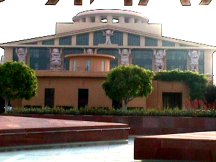
Question and Answer Session
with the makers of Disney's
Tarzan®
at the advance screening on
June 11, 1999
for the attendees of the 1999
Dum-Dum
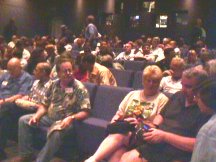
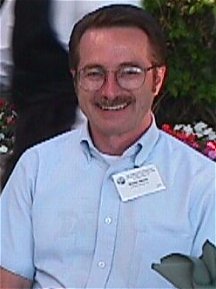
as recorded and transcribed by
Wayne E. James
Copyright © 1999
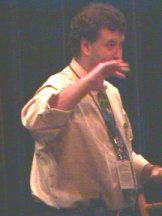 |
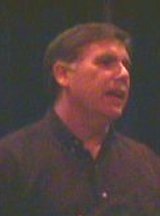 |
|
Vice-President: Studio Communications |
Bibliophile and background animator |
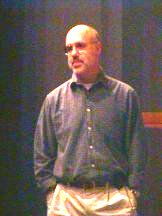 |
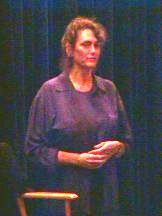 |
|
Screenwriter |
Screenwriter |
NOTE: AUD: indicates question and/or comments from the audience. I apologize that I cannot be more specific about who is asking the questions.I used a micro recorder during the question and answer session and, although it did a reasonable job, there are areas where I cannot make out what is being said. Due to crowd noise I have had to fill in some of the text from memory and context. This text is shown in red. What I can not make it out is indicated by ???? If you know what the text of any questionable area should be, please send it to wejames2@earthlink.net. I will compare it to my recording, as I have found that once I cleared up a difficult section and knew what was being said, it was easier to understand what was being said. If you can help me fill in the blanks, I will definitely give you credit for it.
~~Wayne JamesHG: After this presentation the group's got a little walk to the theater. I apologize for any closeness in this room during this presentation. It takes about 20 to 25 minutes. We are very lucky to have Bob Tzudicker and Noni White who were two of the screen writers. There was a third screen writer as well, Tab Murphy, who wrote Gorillas In The Mist. These folks also worked on Lion King and were (applause) ????.
I will let them tell you a little bit about their process in adapting the book and working on animated films and a whole different way of writing and then we will take some questions and move on to the theater. So, oop, hold it, a question already.
AUD: Are you going to have copies of your book for sale?
HG: I am going to do a book signing after the screening tonight.
BT: We are two of the 1175 people who worked on this movie. We only worked on it 15 months, they worked on it for a good four to five years. Not all of them, but by the time it was over that many people had worked on it.
NW: We trust that if Edgar Rice Burroughs were alive today he would really enjoy the movie that you are about to see. We thought Tarzan was the great opportunity, a great responsibility. The thing that is so amazing about doing Tarzan in animation is that Tarzan actually gets to do what he was meant to do, what he was written to do in his books.
BT: That no real actor could ever accomplish because he couldn't move that way. But Glen Keane, the animator of Tarzan, actually designed Tarzan as if he had been raised by apes, which, you know, without genetic engineering we can't really do with actors.
AUD: ????
BT: Yes! (laughter)
NW: And that is how Tarzan moves and walks and reacts. He reacts like, like an animal. Like ???? kids.
BT: So when we came on the process, we weren't in right at the beginning, Tab Murphy had done several drafts of the script. It's a very long involved process of writing any feature film and animated films are no different. When we came in we said to the director, "What is this movie about?" Hoping that they would say what they said, which is: "It's about Tarzan's identity. Is he a man? Is he an ape? And it's about how man fits into the natural world." And...
NW: And the other thing that was really impressive to us was, you know, what makes up a family. How are families made. Because Tarzan is very much, you know, loving family in the film. One family is succinctly his family.
BT: And in fact is his family.
NW: Right!
BT: So, I really hope that you enjoy the film and that you like the film. There are many differences between this film and the first Tarzan book. The changes are dramatic. It is not a telling. It's not a remake of that story either. It's a new story based on the character of Tarzan and the setup for his experience.
NW: And also, it's bringing Tarzan into the modern day. I mean, that was ah... that book was written the mid... nineteenth century...
BT: I know we're revealing I forget... (laughter) ????
BT: Where I would characterize the book, to my reading, and you may all disagree, to my reading the book dramatically had a lot to do with man's dominance of nature, and his natural place as a dominant species and more specifically a noble Englishman being dominant. And that thematic structure doesn't quite apply to this. This movie is about man's place, fitting into the natural order. And it necessitated time, and being part of, and it necessitated certain story changes and various choices have to be made. Are there other human beings in Tarzan's world? By our telling you this story, because it's about his identity...
NW: (something said too low to pick up)
BT: I'm not going to ruin it!
NW: Ok. (laughter)
BT: We're married also.(laughter) Lost my train of thought. (laughter) Let's do questions at this point. All right let's do ???? (laughter)
AUD: It seems like the gentleman read the original Tarzan of the Apes cause ah, did you guys read just that book, or did you read that book, or did you read more Tarzan as written by Edgar Rice Burroughs?
BT: I stopped at that book. That was the book that was given to us to read. If you are adapting material, sometimes you don't want to fill your head. It's like doing research on a movie that is about some historical event. It's just wonderful to absorb a certain amount of what happened, but you're going to end up cutting so much stuff that you love that it becomes very painful. So I don't know the Tarzan works after the first one, because the first one was the book of subject.
NW: Now, it... Excuse me...
AUD: So you read it and she didn't?
NW: No! No! No! No! (laughter)
AUD: Oh! Ok. I was gonna say, it's a good wife who was telling you ???? the story you write (laughter and boos at the person making the remark, as if it were derogatory towards the wife)
AUD: ???? Green ????.
NW: He may well have read more than we did. But we don't really know. I mean, he's a friend of ours, but we don't know how much he read.
BT: The animated film goes through a process. Usually, they'll get a script in the development process, and then as it goes into production it needs constant revision, because it's a collaboration. So we would go into meetings with the key directors, producer, and the head of story, who manages a team of story board artists.
NW: Occasionally an animator.
BT: And we would talk through: Ok, what do we need to do? What's this sequence about? What's the setting? What's going to happen? And we go off and write it. We come back in. We discuss what we've written. Go back and rewrite it.
NW: And, then also when it gets to a point where the (I don't know how familiar you are with the animation process) but then it gets set up on story boards.
BT: Which are literally, blank pieces of paper that somebody draws on. You know, what you're going to be looking at. So they take the script pages and draw frame by frame, but not frame by frame as it would be animated, there are far too many. So it's like a shorthand of what the story is.
NW: Yeah, yeah. And so, sometimes what we had written wouldn't quite, you know, sing on board. Or sometimes what we had written would be so enhanced by the board artist who thought it into their care. So it's an amazing, an amazing collaboration.
BT: So I think there are about 20 sequences in Tarzan. I can't remember how it ended up being divided up. We have about 600 files on the computer for Tarzan.
NW: So, that's how many time we've rewrote.
BT: The number of rewrites of various sequences.
AUD: Are there any scenes that you love that either went to story board but didn't progress further, that you liked?
NW: Not... Not...
AUD: Or something along those... You know, any scenes that were omitted later? Even scenes that were filmed but they...
BT: I would say more in terms of... not. I can't remember anything that I loved, as a whole sequence, that got omitted. Lots of lines...
NW: But pieces. You know.
BT: Lots of character pieces, that there's no time for. It's a ruthless form. You get to end everybody, to tell them the... long... story.
AUD: Disney films are often reputed as being aimed at children, but I know recently ????. Could you talk about your extreme writing process? How you aim the story at a particular maturity level? How you try to incorporate for the adults in the audiences?
NW: Well, you know for me a friend...
BT: Did everyone hear the question in back?
NW: A friend of ours, who's a psychologist, said they did a paper once on children's literature and adult literature. And they said, the difference between children's literature and adult literature is that at the end of children's literature there is hope. And so... (laughter). And so there is something, you know, to be said. We always require to incorporate that. But I think we are very aware that we are making a Disney film, but we never, ever, condescend to our audience. I would never say, "Oh, you know uh..." Well for instance I think there are parts of this film that children will enjoy, perhaps more than adults, perhaps not, but I think there are parts of this film that will resonate with children very very deeply. And there may be some things that go over a child's head. It's not anything that we mean to, but, you know, children kind of absorb what they can absorb.
BT: We just do the best we can, and there's really no difference. I mean, of course you don't use certain language. You don't show drinking, smoking. You know, there's certain things, even if we want to show, that...
NW: We're not allowed to.
BT: we don't do in the movie. But otherwise telling a story is no different for adults than for children. Adults are just smart children. (laughter)
AUD: How long does it run and how did it feel to read the Time Magazine review?
NW: You know...
BT: It was a happy day! (laughter) You don't often... get that!
AUD: How long was, is the movie? How long is the movie?
NW/BT: 80..., 82, uh... 84 minutes
NW: You know, as a friend of mine's mother used to say, "My, my, peaches and pie." That's how I felt. You know, I think the thing that was so rewarding to me about the Time piece was that I felt that everything that we, as a collaborative effort, you know the directors, the artists, the animators, us. All of us really wanted to put things in this film that were important to us, that we thought were important and integral to this story. And I think that he mentioned all these things, and that to me was the most heartening part of that review. As far as I'm concerned, what I wanted to be on the screen, what we all hoped for, he got. And that is the most...
BT: It was most gratifying.
NW: ...rewarding... thing.
AUD: ???? Star Wars should a been?
NW: Well... (laughter)
BT: There's room for everybody. (laughter)
NW: Everyone freaks out and, we have a three month baby so we haven't seen any movies.
BT: Right! (laughter)
NW: ????
AUD: As screen writers do you have a say in how the characters look and why did you try, if so, to make Jane look so different from the original script?
NW: We had nothing to do with that.
BT: No! That took place before we were on the picture. And generally, we may describe them in some way, but the artists really have... the artists, executives, the whole structure of the company approves, the way the characters look. Its a whole different process.
NW: And also now, we're working on something in development where we're in the girsy-getting (sic) stages of something. And even though the directors have a very firm picture in mind of who they want their characters to be and what they want them to look like, we will occasionally, you know, we'll give our opinion. It isn't always, you know, directors have a very strong vision of what they want and visual development of these films is a very complex process.
AUD: I read that in searching the files they found that Walt had done some material back in the forties on Tarzan and some of that is showing up in the film. How much material did he do back then and how much of it shows up in the film?
BT: I don't know the answer to that. We've heard that he did some development and that Salvador Dali was involved. I don't even know if it's true. I think that's the sort of thing that would show up more in Howard's book or...
HG: I didn't know about that. (laughter) We did find... I don't know if you are familiar with these letters that Edgar Rice Burroughs had written to his son Jack, in 1936, discussing the animated project that he had a plan gathered, a desire to make an animated feature and a couple treatments were written and revamped and we turned up these letters recently. They are quite interesting because in it he says that the animation should be excellent and should approximate Disney excellence. And it talks about humor and it talks about the naturalism and it's interesting that we discovered that after we'd made the movie but it kind of indicated some of the things, some of the choices that the directors had made. I wasn't aware that Disney himself was... I'll have to look into that. (laughter)
AUD: Burroughs Incorporated... when you made these changes how much leverage did they have? Did they say, "No, you can't do that." or "Look, put this there." or...?
HG: We never pre-arranged...
BT: It never came to us. I think there were certain contractual requirements, but they were very reasonable and very few as far... Tarzan couldn't be seen to be drinking or smoking, that sort of thing.
AUD: ???? Jane, that kind of stuff?
NW: Yeah.
BT: Actually, they omitted that from the contract.(laughter) And that scene got cut. (laughter)
AUD: When you were writing and then the music came into the film did you have to do something, more writing or some changes, at that point too? To introduce the music?
BT: You have to ramp into a song and come out of it. So the content of the song and the song will always absorb a certain amount of story telling, especially in this movie. A lot of story telling happens during songs so that will shift when the lyric comes in, you realize, "Oh, we need to cover this piece of story before or after the song."
NW: Although this film is not a break-into-song musical. No, this film is... you know, there are songs in the movie, but it's not... no one stops and goes "La da daa da daa, I love you so." You know... (laughter) it's not that kind...
AUD: How long a period from the time you came aboard until today?
NW: Oh my.
BT: It's been, ah, two and a half years ago, I think, that we came on boooaard.
NW: And we were on board 15 months.
BT: Yeah.
NW: And then, you know, we go away and they do their magic. They fully animate it. They color it. They do all the clean up. It's an amazing process.
BT: The passion for this project is... I've never seen the like at this or any other studio. All the artists are very passionate about this project.
NW: Definitely.
AUD: One of the more controversial characters in your movie, Mr. Burroughs concludes, Terk. Would you like to say anything about that?
BT: No! (laughter) I wasn't aware of the controversy. I think that there is a certain need for a certain level of comedy in these movies and I think it is part of what appeals to younger kids. And Terk carries some of that burden. She gets that kind of spunkiness. So I don't know the nature of the controversy.
AUD: (Multiple sugestions to "Explain, explain.") (laughter)
AUD: Well they've taken a gorilla, err... an ape that was Terkoz, turned it into a young lady friend... err... girlfriend ah... nah, wrong word (from audience "playmate, tom boy") yeah, tom boy kind of character and Rosie O'Donnell plays the role and the kind of humor was just very very different from anything done in either the original novels or anything Burroughs ever wrote. And it clearly leads to discussion, I've not seen the film. The discussion made it sound like it was really being aimed at very little kids and interrupting the grimness of the original story.
NW: Well, I don't really know. I mean I certainly want them... Our intention of perhaps a true but... but we always hope... We hope that our comedy comes out as talented. And that she is his little tom boy, kind of rough and tumble and... I mean you'll see for yourself in just a...
BT: I think the grimness of the original story is not present in this story. It's in much smaller doses. So I think it's less of a shock to see a character, you know, whose name was chosen just because it's a very interesting name. Hopefully we show that any changes in that regard were kind of random, but if disrespect to the original character... ah...
NW: We didn't mean it! (laughter) ????
AUD: You mentioned a prior screen writer?
NW/BT: Yes.
AUD: So you were given his script and then based on that wrote your own.
NW: Well, no. That's kind of the way of the Hollywood world and especially in a process like... It happens in the live action world all the time. But in animation, because these things do take so very long to come to fruition, they often, and I don't necessarily agree with them, but they often put different writers on a project. They think... it's funny, because in a live action world they think of us as comedy writers. And in the animation world we're kind of a serious person. So it's funny that they think of us in different ways in different aspects of the business. So, you know, as far as I'm concerned we can do all those things just like most actors can play any part.
AUD: Well did you just throw his script away?
NW: No no. No! No!
BT: There were actually writers in between and...
NW: Several.
BT: and a number of them who worked in the production rewrite process. And when we came on, in fact, we returned... we would keep Tab's script nearby, and would return to Tab's script. That's why all three of our names are up there. His script has a different focus, to some extent.
AUD: And your job was to change the focus?
NW: No! No! Not at all. I mean our job really... Well our... Yes! To a degree because the directors wanted to change the focus.
BT: Yes.
NW: And in the end it's their movie and that's what we have to respect. But um... I was going to say something. Um... ???? Um... Aaa... Oh! Oh! Wait, aaah... (laughter) Oh! Because we are original screen writers ourselves also, I mean that's what we do we write screen plays, we always try to... if there's something we really respond to in an original writers screen play we keep it and we've even turned down and lost jobs because we didn't want to change scripts enough. You know they'll call us in and say "Well take a look at this." And we'd go, "This is great, I mean we would do this and this and this, but this is great." Often times they want the baby thrown out with the bath water.
BT: Tab wrote a really... strong... script.
NW: He did.
BT: It really, it stood by itself.
NW: And so our script is very different than his.
BT: But it didn't focus with... Go ahead.
NW: Yeah.
AUD: And they didn't want that focus?
BT: No, they wanted it shifted a bit.
AUD: So you were brought in as... abetters? (laughter)
NW: It's funny, because we followed Tab on the Hunchback as well.
BT: And worked concurrently with him on Hunchback, for awhile.
NW: Yeah, he's a wonderful guy. We're friendly. There's no, you know, there's no animosity between us at all.
AUD: I'm wondering, why didn't they just keep his script?
NW: Because it didn't resonate itself.
BT: It was less focused on the identity issue of Tarzan. So, and had more focus on, as I recall, and remember now it's been all these years since we've been involved. We've had several projects since then.
AUD: Would you consider yourselves screen doctors?
BT: In this process?
AUD: Yeah.
BT: They tend to hire us as screen doctors.
NW: Yes.
BT: Right now we're working on... we're the first writers on a project.
AUD: So someone else is going to doctor your script? (laughter)
NW: Possibly, yeah. And we can almost rest assuredly, as my mother would say, that there will be change, but not the whole thing.
AUD: So between Lion King and Tarzan which is your favorite.
BT: Tarzan. (laughter amid "that's expected" type of comments)
NW: No, absolutely Tarzan. This is the most ????
HG: No, no, I want to introduce one more person. Phil Phillipson is one of the background painters on Tarzan and he is a member of Bibliophiles. So I thought he might come out and say something. (applause) Phil, you want to talk a little bit?
PP: Yeah. I'm a background painter ???? Tarzan. I've been a Bibliophile off and on since 1967, but most ???? for the last 10 years and one of the things I find really satisfying about Tarzan is the sequence of events ???? In all the dozens of versions of live action based on the story, this is the first time the tribe has ever been a central part of the story, that you get to see Kerchak and you get to see Kala. Even though some of the parts aren't quite exactly the same as the novel, the essence, and the sense of scenery, and the sensitivity is there. And its the first time the tribe's ever been in ???? in a Tarzan movie. That I am the most proud of. Not that I wrote it, but (laughter) ????
NW: Yeah. You know, we did this, we wrote this movie with the utmost respect for the original material. But of course we, I mean, we had to make a very different movie. If you would go back and read that novel today I don't think you would make that movie specifically. There are things about it that you would probably change.
BT: But we'd have never met.
NW: I know.
???? ??: What is the big ????? (laughter)
HG: We've got time for a few more questions, then we really should start walking...
BT: The gentleman back there in the black tee shirt.
AUD: Yeah. Disney has until this fall to, as Danton Burroughs put it, step up to the plate for John Carter of Mars. Do you know if there is a script floating around here any of you?
BT/NW/PP: I don't know. I don't know.
HG: I know there was interest at one time. There maybe still is.
AUD: The trailer is the one thing that I... your background art, is the one thing that I really enjoyed seeing was the three-dimensional background jungle that ???? I wondered if you had, because you are a Bibliophile and presumably read the book, if you had a lot of input into creating Tarzan's jungle?
PP: No, because of the way the production process works. As far as story content, no I don't have any input, but as far as visuals go I did have some input in as far as color and design, but then again I have to defer to the art director in production design. But in my own small way I tried to get as much of the jungle in there as I possibly could.
AUD: But it is, from what I've seen, it's the jungle we've always dreamed of.
NW: ????
AUD: And I'm looking forward to it.
PP: Yeah, the deep-canvas effect. And we tried to bury the computer induced digital look so it didn't look like Toy Story or something really super slick. That it looked like a painting which is what we are doing. We were literally taking on the ???? with a digital pad, painting each tree trunk and the mosses and everything that follows.
BT: It's like handmade movies. Every frame is slaved over by dozens and hundreds of people. Every single frame. And it's very exciting to me that you're a group that is dedicated to the books, because you are going to see something quite different and that tension is... (laughter)
AUD: I was wondering if you had any preconceptions of Tarzan before you came on to the project ???? and movies that had gone before? And what your reaction was? If you felt that it's something that's been done before?
BT: My first reaction was, "Why in an animation?" When I first heard about it I didn't get it.
NW: And it never crossed my mind "Why an animation?" because I knew that we could fly, that we could really enter this world, that we could go into the jungle and we could do this film.
BT: I'm a little slow. (laughter)
NW: ????
AUD: I have a question for Phil. Are there cells for this? Was there ever cells?
PP: Not initially. Cells are not a product of this process. But they do hand cells for special archive purposes. Now when they do cells they stick them in a computer ???? an animator draws on paper and that paper is scanned into the computer. The computer transfers ???? like a coloring book ???? and different colors.
HG: We'll take one last question and then we should start...
AUD: ???? background?
PP: What happens is once it moves digitally, we're done in the computer. But, we painted those. So we feel they are painted. Because, just imagine you are painting on glass, if I were painting in front of you. I would then paint the tree and go all the way around and literally...
AUD: Do the lions look like the lions from Lion King?
PP: You'll find out?
HG: We'd like to thank our guests for coming out here tonight. (applause)
Disney's Tarzan © Burroughs and Disney.
Tarzan® is owned by Edgar Rice Burroughs, Inc.
Visit the ERBzine 0181 for more photos


![]() .
WEBJED:
BILL HILLMAN .
.
WEBJED:
BILL HILLMAN .![]()
Visit
our thousands of other sites at:
BILL
and SUE-ON HILLMAN ECLECTIC STUDIO
Some
ERB Images and Tarzan© are Copyright ERB, Inc.- All Rights Reserved.
All
Original Work ©1996-2004/2018 by Bill Hillman and/or Contributing
Authors/Owners
No
part of this web site may be reproduced without permission from the respective
owners.